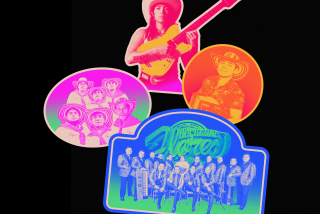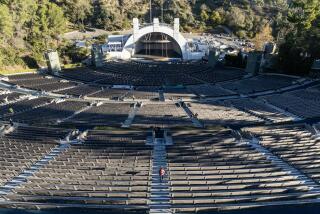Review: Herbie Hancock and friends ‘Celebrating Peace’ at the Bowl
There was little idea of what to expect going into Herbie Hancock’s show at the Hollywood Bowl Wednesday night. All we knew was that there would be a Rolodex worth of guests, including guitarist Carlos Santana and Hancock’s longtime collaborator Wayne Shorter, and that the program would be “Celebrating Peace” -- an admirable theme, certainly, but one that opens up a whole variety of possibilities.
Would this be an evening of revolving, interchanging ensembles along the lines of last year’s show exploring “Joni’s Jazz” or Hancock’s 70th birthday concert in 2010? At least on paper, the night’s lineup hinted toward that kind of show with a doubled-up rhythm section that included bassists Marcus Miller and Dave Holland along with drummer Cynthia Blackman Santana and tabla master Zakir Hussain.
Instead, the concert was led by a single, all-star octet, an ambitious plan that pointed toward Hancock’s long-held commitment to merging styles. The many sounds and personalities in play were an audacious move, but the results ultimately were mixed.
PHOTOS: 2012 Hollywood Bowl highlights
After an energetic set by Grégoire Maret acrobatically explored the high-timbred possibilities of jazz harmonica, Hancock began with an unsettled, amorphous overture that featured the keyboardist on wooshing synthesizers mixed with samples of Martin Luther King Jr. speeches and what sounded like children playing. Eventually the band settled into a sprawling take on Mongo Santamaria’s standard “Afro Blue,” which was anchored by Hussain’s percolating tabla. With so many moving parts in play, the song shouldn’t have worked but did, particularly as Santana and Shorter traded melodic flutters that gave way to Hancock, whose keyboard tone mimicked a trumpet.
With Miller’s popping Fender bass often overwhelming the rich, acoustic tones of Holland, the breezy “Sonrisa” was less successful amid Blackman Santana’s cymbal-heavy rhythms and Shorter’s soprano saxophone, resulting in something that resembled Sting’s jazzier excursions.
Hancock’s electronics-shaded vocals formed an ambient interlude between songs as his keening textures sometimes resembled a sad robot.
An expanded take on Hancock’s “Dis Is Da Drum” from his 1994 album of the same name unleashed Blackman Santana with a furious funk groove, and Hancock earned cheers for breaking out the keytar for squiggly excursions that recalled the roller-rink funk of Prince, even with the left-field addition of Santana’s bandmate Andy Vargas on wordless vocals.
Vargas’ contributions were stronger in a cover of Michael Jackson’s “They Don’t Care About Us,” a fitting birthday tribute to the late pop star that felt even more timely given the backdrop of a contentious election season. With Vargas’ rapped vocals and a pointedly off-balance piano solo from Hancock, a few concertgoers near the front pumped their fists to a stinging solo from Santana as the evening drew closer to resembling genuine protest music befitting its theme.
Although the performance often felt like a work in progress, you have to give Hancock credit for stretching out and testing his limits, particularly on a warm summer night at the Bowl. With long, globally informed explorations, the evening worked to conjure a more psychedelic, experimental era in jazz when there were no boundaries.
“For peace!” Hancock reminded everyone after the night-closing “Novus,” a song from Santana’s 2002 album that featured a jarringly operatic vocal from tenor Kalil Wilson over a swerving Latin rhythm. The evening didn’t always hold together under its idealistic banner, but the same could be said for all of us.
ALSO:
L.A Phil extends jazz contract with Herbie Hancock
Live review: Herbie Hancock at Walt Disney Concert Hall
Twitter: @chrisbarton
More to Read
The biggest entertainment stories
Get our big stories about Hollywood, film, television, music, arts, culture and more right in your inbox as soon as they publish.
You may occasionally receive promotional content from the Los Angeles Times.











